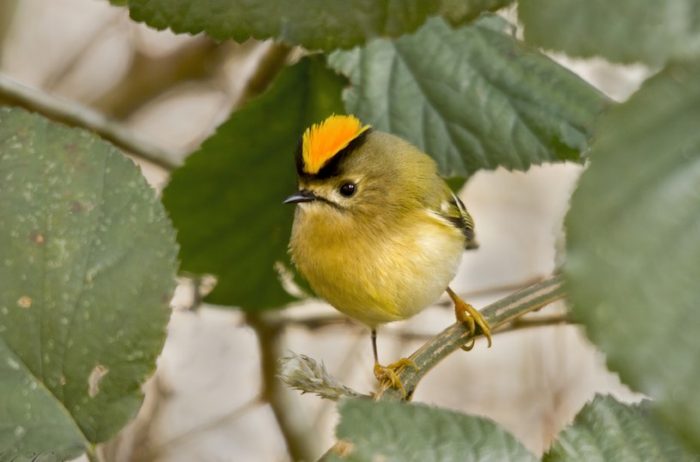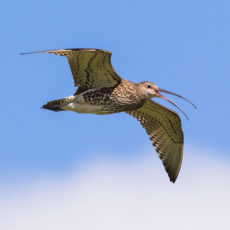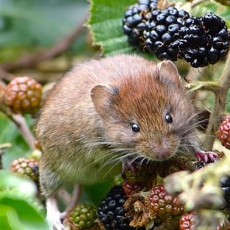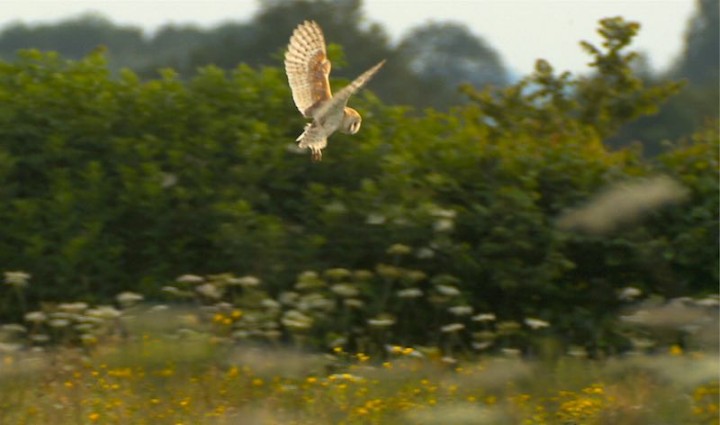Whilst working on the computer, I heard a thud on the window which sounded as though it may have been a bird. Much to my surprise a beautiful goldcrest was lying on the mini meadow on its front just beneath the sitting-room window with its small, olive-green wings spread out, dazed and motionless.
It was raining lightly and freezing cold which would not help it survive the shock of the impact. So I ran to the meadow, scooped it gently into my hands, cupped them with its protruding legs clasped gently between my fingers and brought it indoors. I turned off the radio and made sure that the room was quiet for this tiny bird in these unfamiliar surroundings. I held it close to my body for additional warmth for about 15 minutes until it felt warm and was trying to move its legs. When it suddenly raised its crest it was a sign that it was recovering.
I was delighted and my anxiety began to subside. I had always hoped to see a goldcrest with its crest raised, but never thought that it would happen whilst cupped in my hands. At this point, I was too concerned about its welfare to try and take any images.

A moment of beauty and relief
After another five minutes of quiet joy at being able to look at the beauty of this fragile, tiny bird, its bright eyes and resplendent yellow crest, it kicked its wispy, delicate legs and tried to break free with a more determined effort. I opened the window and anxiously faced it towards a bush: had its brain really fully recovered from the impact to enable searching for food and was it warm enough?
The goldcrest flew from my hands, landing momentarily on a small bush honeysuckle alongside the window, then to the cotoneaster shrub in the mini meadow. It sat there briefly and then disappeared into the shrub. I could see it constantly moving around searching for and picking off insects underneath leaves. Relieved that the goldcrest had fully recovered, I rushed to find my camera in the hope that it would reappear on an outer branch where it had initially landed after being released. It did, and sat there for some moments as it searched for insects and then fluffed its feathers. I managed to film this happy moment before it flew into the depths of the bush again and then out and up into a tall tree.
All it took was just 20 minutes of my time to warm this tiny bird with gentle reassurance before being released back to wild. I had always hoped to be able to get some footage of this charismatic little bird, but never expected the encounter to be quite this close or as moving because of its frail beauty and lightness of being. I was in awe. You never quite know when your next close wildlife encounter is going to be. Even when you are sat indoors and otherwise engaged! I feel so privileged to have held this exquisite, sparkling beauty in my hands.
Advice on rescuing birds that hit windows
- If the bird is clearly distressed whilst in your hands, gently place it in a small cardboard container such as a shoe box with a lid.
- Place the box somewhere warm and quiet, out of the reach of any pets or young children.
- Do not try to feed the bird or give it water.
- The darkness whilst in the box will help to calm the bird down and it warm up as it revives. This should take no more than 20 minutes.
- If the bird is not alert within two hours then take it to a vet or wildlife sanctuary for assessment.
Goldcrests are Europe’s tiniest bird
An adult goldcrest weighs only six and a half grams which is roughly the same as a 5 pence coin and yet this tiny bird embarks on long distance migration. Our resident birds are joined by migrant ringed birds that have revealed regular movements between countries from the Baltic and North Sea into Britain to overwinter. One bird had flown from Russia and several had reached the UK from Poland. Having held this little bundle, almost as light as air, that is an astonishing fact!
The only way you are usually aware of their presence is by hearing their very quiet, high pitched “tweedly tweedly tweedly twiddleedidee song”. Or their contact call allowing them to move in groups which is a quiet “si” or “siii, siii” and can be confused with a Treecreeper’s call. The song and call of the Firecrest is similar to that of the Goldcrest, but it is louder and the song does not have the flourish at the end. Their song is unfortunately out of the hearing range of many people.
Their thin beak is perfectly designed for picking out insects between pine needles, tiny morsels such as moth eggs, spiders and other small insect food. So their favourite trees tend to be pine, spruce and fir. During extremely cold winters they will visit gardens in search of insects and will take crumbs of bread and cheese from bird tables.
A sighting of one is always a moment of joy.



